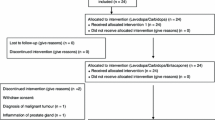Abstract
Tolcapone (T) is a novelcatechol-O-methyltransferase (COMT) inhibitor recentlyintroduced for the treatment of Parkinson's disease. Inclinical efficacy studies, T has been associated with alow incidence of diarrhea. The objectives of the study wereto examine whether T and its adjunctive drug Sinemet (S)could influence intestinal fluid and electrolytetransport as a possible cause for the diarrhea. The studies were conducted in conscious dogssurgically prepared with Thiry-Vella loops constructedfrom a 40-cm jejunal segment. A physiologically bufferedtest solution was perfused into the orad stoma and collected from the caudad stoma. Secretionswere collected at 15-min intervals and analyzed forvolume, electrolytes, lipid phosphorus, and protein. Theacute oral administration of T (10 and 30 mg/kg doses) was well tolerated. Concurrent acuteadministration of S (25 mg/kg) with T (30 mg/kg) wasalso well tolerated. The acute oral administration of Tinduced a dose-dependent efflux of intestinal fluid and electrolytes (sodium, potassium, chloride, andbicarbonate) secretion (P < 0.05). The oralcoadministration of S (25 mg/kg) with T (30 mg/kg)accelerated the onset of the stimulation of intestinalsecretion. Despite the significant stimulation ofintestinal secretion, none of the dogs developeddiarrhea, indicating the importance of intestinalcompensatory mechanisms. Neither T nor T&S affectedcalcium, lipid, or protein efflux rates, suggesting thatthe stimulated secretion was not a consequence ofintestinal mucosal injury. The chronic (seven-day)administration of T and T&S was associated withreduced intestinal secretory responses when comparedwith the acute administration of the same drugs; Senhanced the T-induced tolerance development. The basisfor such tolerance is unknown. In conclusion, the stimulatory systemic actions of tolcapone onintestinal secretion may, under certain conditions,contribute to the induction of diarrhea in susceptiblepatients.
Similar content being viewed by others
REFERENCES
Borgulya J, Da Prada M, Dingemanse J, Scherschlicht R, Schlappi B, Zurcher G: Ro40-7592: Catecholamine-O-me thyltransferase (COMT) inhibitor. Drugs Future 16:719-721, 1991
Rajput AH, Martin W, Saint-Hilaire MH, Dorflinger E, Pedder S: Tolcapone improves motor function in parkinsonian patients with the “wearing-off” phenomenon: A multicenter double-blind, placebo-controlled, multicenter trial. Neurology 49:1066 - 1071, 1997
Baas H, Beiske AG, Ghika J, Jackson M, Oertel WH, Poewe W, Ransmayr G: COMT inhibition with tolcapone reduces the ”wearing off” phenomenon and levodopa requirements in fluctuating parkinsonian patients. J Neurol Neurosurg Psychiatry 63:421-428, 1997
Gullikson G, Dajani EZ, Bianchi RG: Inhibition of intestinal secretion in the dog: A new approach for the management of diarrheal states. J Pharmacol Exp Ther 219:591-597, 1981
Bright-Asare P, Binder HJ: Stimulation of colonic secretion of water and electrolytes by hydroxy fatty acids. Gastroenterology 64:81-88, 1973
Thomas MV: Arsenazo III forms 2:1 complexes with calcium and 1:1 complexes with magnesium under physiological conditions. Biophys J 25:541-548, 1979
Zilversmit DB, Davis AK: Micro-determination of plasma phospholipid by trichloroacetic acid precipitation. J Lab Chem Med 35:155-160, 1950
Taylor JA, Mir GN: Alpha adrenergic receptors and gastric function. Drug Dev Res 2:105-122, 1982
Schultz E: Catechol-O-methyl transferase and aromatic-L-amino acid decarboxylase activities in human GI tissue. Life Sci 49(10):721-725, 1991
Flemstrom G, Safsten B: Role of dopamine and other stimuli of mucosal bicarbonate secretion in duodenal protection. Dig Dis Sci 39:1839-1842, 1994
Flemstrom G, Safsten B, Jedstedt G: Stimulation of mucosal alkaline secretion in rat duodenum by dopamine and dopaminergic compounds. Gastroenterology 104:825-833, 1993
Gorelick FS, Jamieson JD: Structure-function relationships of the pancreas. InPhysiology of the Gastrointestinal Tract. LR Johnson(ed). New York, Raven Press, 1981, pp 773-794
Aho PA, Linden IB: Role of gastric mucosal eicosanoid production in the cytoprotection induced by nitecapone. Scand J Gastroenterol 27(2):134-138, 1992
Dajani EZ: Misoprostol: Pharmacology, pharmacokinetics and mechanisms of action. Exp Clin Gastroenterol 1:97-106, 1991
Dajani EZ, Wilson DM, Agrawal NM: Prostaglandins: An overview of the worldwide clinical experience. J Assoc Acad Minor Physicians 2:23-25, 1991
Dajani EZ, Roge EAW, Bertermann RE: Effects of E-prostaglandins, diphenoxylate and morphine on intestinal motility in vivo. Eur J Pharmacol 34:105-113, 1975
Slomiany BL, Liau YH, Lopez RA, Slomiany A: Nitecapone effect on the synthesis and secretion of gastric sulfomucin. Gen Pharmacol 14:69-73, 1993
Rights and permissions
About this article
Cite this article
Larsen, K.R., Dajani, E.Z., Dajani, N.E. et al. Effects of Tolcapone, a Catechol-O-Methyltransferase Inhibitor, and Sinemet on Intestinal Electrolyte and Fluid Transport in Conscious Dogs. Dig Dis Sci 43, 1806–1813 (1998). https://doi.org/10.1023/A:1018852223902
Issue Date:
DOI: https://doi.org/10.1023/A:1018852223902




